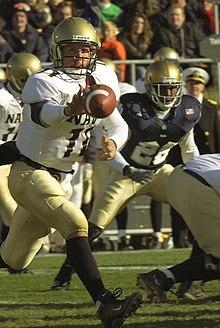
In gridiron football, a lateral pass or lateral (officially backward pass in American football and onside pass in Canadian football) occurs when the ball carrier throws or hands the football to a teammate in a direction parallel to or away from the opponents' goal line. A lateral pass is distinguished from a forward pass, in which the ball is thrown forward, towards the opposition's end zone. In a lateral pass the ball is not advanced, but unlike a forward pass a lateral may be attempted from anywhere on the field by any player to any player at any time.
While the forward pass is an invention of the North American games, the lateral and backward pass is also a part of rugby union and rugby league, where such passes are the norm. Compared to its use in rugby, laterals and backward passes are less common in North American football, due to a much greater focus on ball control in American football strategy; they are most commonly used by the quarterback, after taking the snap, to quickly transfer ("pitch") the ball a short distance to a nearby running back (or, rarely, wide receiver) on a rushing play. Laterals are also often seen as part of a last-minute desperation strategy or as part of a trick play. Examples of plays utilizing the lateral pass are the toss, flea flicker, hook and lateral, and buck-lateral.
